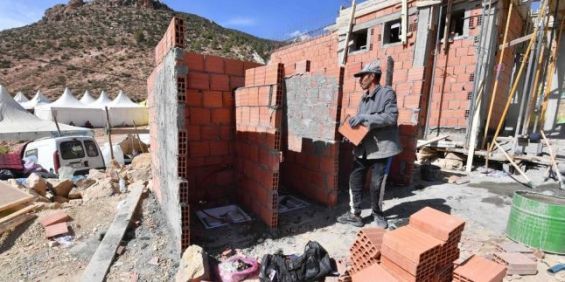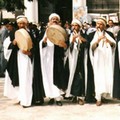Nearly one year after the devastating earthquake that struck the Marrakech-Safi Region’s Al Haouz Province and the Souss-Massa Region’s Taroudant Province, claiming 3,000 lives, many affected families are still struggling to find shelter, citing delays, obstacles, and even alleged exclusions from aid.
Shortly after the M6.8 earthquake hit the region, the Moroccan government announced a plan to rebuild and provide funds to rehouse survivors. Families who lost their homes entirely were to receive 140,000 Moroccan dirhams to rebuild, while those whose homes were partially damaged would get 80,000 dirhams.
However, according to local associations and survivors, some families who believe they should be eligible for the rebuilding funds claim they have been excluded, while those who did receive some aid have reported delays and irregularities.
A member of a local association in Moulay Brahim, a small town and rural commune in Al Haouz that was heavily affected by the earthquake, described the situation as a «bitter reality».
A lengthy process
«No family has been able to fully return to their homes or completely finish reconstruction work», he explained. In this area alone, there are over 200 families who lost their homes to the earthquake. «Only 15 families have begun rebuilding, and they are only at the stage of laying metal sheets. Six more are still in the early stages due to a lack of necessary equipment», the same source added.
These difficulties are primarily due to the «insufficient» amount provided to these families—80,000 dirhams—which, according to the human rights activist, «is completely inadequate, especially since it is distributed in four installments of 20,000 dirhams each, while the cost of rebuilding a house is around 120,000 dirhams». As a result, many are forced to take out loans to complete the construction process.
«More than 120 families are living in temporary shelters, such as tents, which is a significant number. As an association, we purchased houses for 20 families and installed 50 containers with water and electricity for people with special needs, the sick, and women who gave birth during this period», he reported.
According to the human rights activist, there has been no tangible progress in rebuilding the damaged houses, particularly in areas designated as «red zones» where construction has been banned. «These areas represent half of the affected population in the region (100 families), and the search for suitable relocation sites is still ongoing».
According to the activist, around 30 percent of the affected population in Moulay Brahim did not benefit from the compensation.
«Tourists used to visit the mausoleum and the Zawiya, which were also damaged and are in the process of being rebuilt», he noted. «In other words, Moulay Brahim has suffered a general economic paralysis».
«To date, the rubble from this disaster has not been cleared, no agreements have been reached with hotel owners and merchants, and no concrete steps have been taken to encourage people to return to Moulay Brahim and rebuild the area», he argued.
Reconstruction obstacles
Similar issues are being voiced by the residents of Tallat Nyacoub, another small town in Al Haouz Province that was also hit hard by the earthquake. Survivors who were allocated funds to rebuild their damaged or completely destroyed homes deemed the amount «insufficient».
«First, the prices of construction materials are high», said a member of a local association. «The funds start with an initial installment of 20,000 dirhams, which isn't enough to even lay the foundations of a house», he told Yabiladi over the phone. He explained that the rest of the installment is only allocated when the house’s foundations are laid.
«Some families had to spend their own money to rebuild. Even those who received the first payment are still waiting for the second one, which is taking too long», he argued.
The activist also reported that some affected families were prevented from using local techniques and materials when rebuilding, «which are less expensive», according to him.
Additionally, the same source pointed out another problem that some families would be experiencing: «If a damaged house was home to three or four families, only one family will benefit from the housing assistance. Where are the others supposed to go?» he wondered.
Excluded households
In other villages, some survivors argue that they were «excluded» from the government funds allocated to affected households. In Tanamart, Adassil, in the Chichaoua Province, Said Akhomach said he was not granted any reconstruction or rehabilitation funds, even though his house was cracked during the earthquake.
«Our village has 140 households, but only 30 of them were allocated funds to begin rebuilding», he told Yabiladi today. Akhomach, who is a member of a local association, said, «some houses are on the verge of collapsing. Despite attempts to protest and voice our frustration, nothing has changed».
Speaking about his own situation, Akhomach pursued, «when the committee in charge visited my house, they determined that it needed to be demolished and that I was eligible to rebuild». «However, it turned out that this wasn't the case. My name was not included on the list of those benefiting from the funds—neither for reconstruction nor for rebuilding», he complained.
«I'm still living in it because I have no other choice. I've lodged complaints twice, but nothing has come of it. I'm not alone in this situation; many others in my village are facing similar challenges», he alleged.
On the other hand, Said Alhoucine from Tasskourt, a village in Chichaoua Province, said that the «struggle continues». Alhoucine, who is president of the Tasskourt Association for Development, denounced what alleged «irregularities».
Speaking to Yabiladi, he said that in his village, «those who didn’t receive any funds were simply told that they are not included». On the other hand, «some households were deemed ineligible for the funds, despite their houses being clearly affected, while others received funds even though their houses were not damaged», he claimed.
He further alleged that «10 of the families that benefited from the funds don’t even live here year-round; they live in Casablanca», while «others who live in the village year-round with no other home have received nothing».
A frustrating situation
In other villages, progress is deemed slow, even a year after the tragedy. In Angokht, a village in the Imindounit commune, out of 120 households, forty would not have «received any funds one year after the earthquake», said Mohamed Al Guamal, president of the Angokht Association for Development and Solidarity, insisting that Imindounit is one of the areas hit hardest by the earthquake.
«Some families are still living in makeshift shelters. An association has helped construct temporary dalakit houses, with two families sharing each one», he declared.
«Our association has tried to voice the residents' frustration, lodging numerous complaints and notifying the authorities, but to no avail. We want the people who truly deserve funding to receive the financial support they need», he concluded.
Recent numbers shared Monday, September 2, indicates that 49,632 housing units were built, following the issuance of 55,142 reconstruction authorizations. The first installment of 20,000 dirhams for housing reconstruction and rehabilitation was received by 57,805 families, the second installment by 20,763 families, the third installment by 8,813 families, and the fourth and final installment by 939 families.
Moreover, eleven out of twelve monthly installments of the 2,500 dirham subsidy have been paid, benefiting 63,862 families.





 chargement...
chargement...













